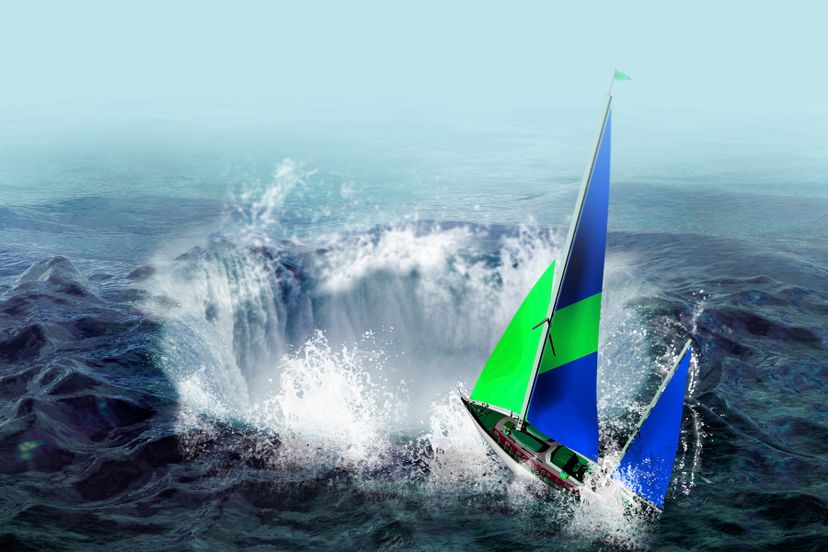
About This Quiz
This ocean area has a reputation for devilry and danger. How much do you know about the Bermuda Triangle? Find out with our Bermuda Triangle Quiz.The Bermuda Triangle extends across nearly 500,000 square miles in the Atlantic Ocean. It's located off the southeastern coast of the United States with apexes in the vicinities of Bermuda; Miami, Fla. and San Juan, Puerto Rico.
Another name for the Bermuda Triangle is the Devil's Triangle, a moniker that may have been borrowed from Bermuda's own alias: Isle of Devils.
In 1945, the story of five Navy Avengers disappearing in the Bermuda Triangle virtually exploded when news reporters linked the accident to other strange disappearances in the same area.
Advertisement
Capt. Robert Lundquist piloted the DC-3 that disappeared somewhere around the Bermuda Triangle. The Civil Aeronautics Board stated that his plane had been having electrical difficulty before take off, and it's likely that he ran out of fuel and crashed into deep waters. No debris has ever been found from the accident.
The Beech Bonanza disappeared in 1981 and the S.S. Marine Sulphur Queen was lost in 1963 -- both accidents are attributed to the mysterious pull of the Bermuda Triangle. The Mary Celeste's crew disappeared in 1872, and while the incident is commonly thought to have occurred in the Bermuda Triangle, it actually happened hundreds of miles from there.
While it's a farfetched theory, at least one psychic, Edgar Cayce, claimed that this area is a portal to the lost city of Atlantis. Cayce explained that Atlantis had many modern-day technologies, which ultimately led to the demise of the city. He said that Atlantis could be accessed by a pathway called Bimini Road, in the Bahamas.
Advertisement
In "The Fog: A Never Before Published Theory of the Bermuda Triangle Phenomenon," Gernon and MacGregor describe how an electronic fog with time distortion capabilities wreaked havoc on their plane's electrical equipment and mysteriously shaved time off their flight to Miami Beach.
The only two places in the world where compasses point to true north instead of magnetic north are the Bermuda Triangle and the Devil's Sea. According to some theorists, this explains why ships and planes get lost in these areas.
Waterspouts (more commonly known as tornadoes) and seismic activity from underwater earthquakes are both thought to attribute to disappearances in the Bermuda Triangle region. Full moons are not considered an influence over ships and vessels in this area.
Advertisement
Dying and decomposing sea organisms build pockets of methane gas that can affect the density of ocean water upon rupturing. Some scientists say that even planes flying overhead during methane explosions can catch fire.
The Prohibition-era ship may have run afoul of booze smugglers.
Some Triangle believers have seized upon this statement as evidence that extraterrestrials may have been involved in the bombers' disappearance.
Advertisement
The 13-man crew disappeared along with the plane, which was never seen again.
Nothing to see here, no supernatural Triangle, so move along folks.
They probably wandered around lost and eventually ended up in the sea.
Advertisement
But this isn't necessarily unusual; it happens in various places all over the world.
Edward Van Winkle Jones wrote a piece about the Triangle for The Miami Herald.
In spite of the intensive search, no trace of the plane or its 31 passengers was ever found.
Advertisement
There were radio blackouts of up to 10 minutes in duration that made communications very difficult. This disappearance helped to start the Bermuda Triangle legend.
He claimed that suspicious people were spotted near both planes before their fateful flights.
It may have just been a meteor; Columbus reported other odd sightings as well.
Advertisement
But a storm came up and the ships were separated; the ghostly ship was never seen again.
The ship never transmitted a distress call and no one ever learned what happened to the ship or its unfortunate crew.
They, too, disappeared and have never been found.
Advertisement
It was found adrift, and its crew had vanished.
Insurances companies, constant bellwethers of risk, don't see the area as more dangerous than other parts of the ocean.
The book took a sensational idea and made it even more fantastic, which was great for sales.
Advertisement
A book called "The Bermuda Triangle Mystery: Solved" concluded that the number of disappearances was no greater than in any other ocean. Many of the "disappearances" or crashes took place outside of the Triangle, or else storms were to blame.
Once the idea took hold, the Triangle became the stuff of legend, even though real-world findings seem to show that it doesn't' t exist.
In the end, the Triangle doesn't seem to be more dangerous than other areas of the ocean.
Advertisement